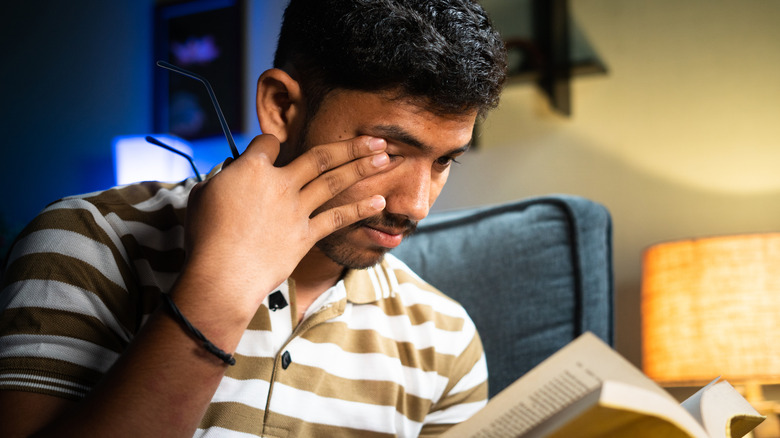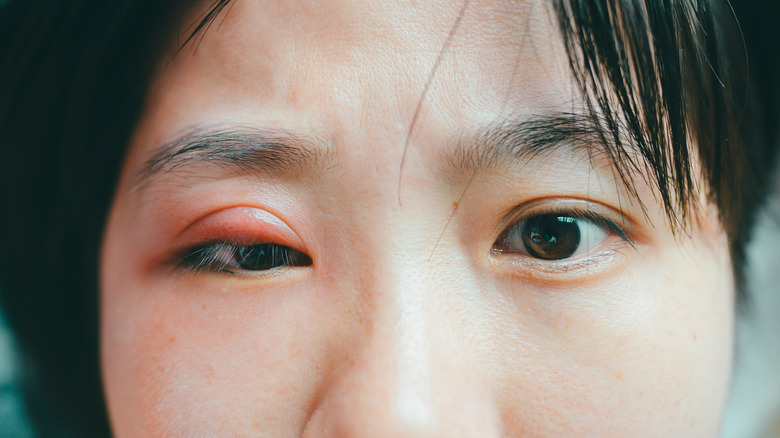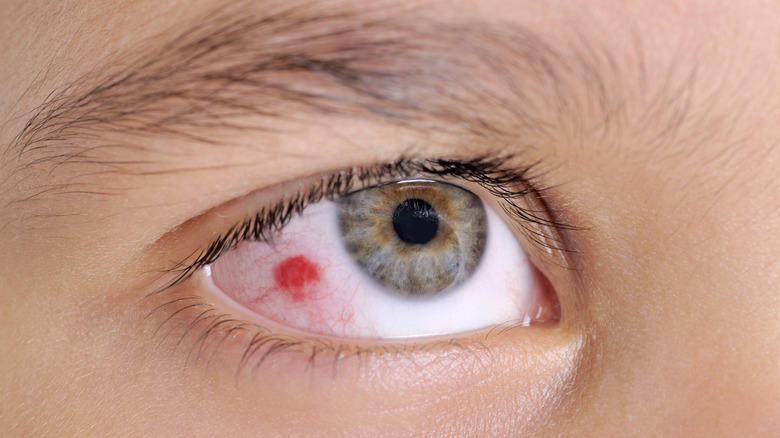Warning Signs From Your Eyes You Shouldn't Ignore
We can tell a lot from the eyes. For example, if someone is exhausted or has been crying, their eyes reveal that. Eyes can express emotions like anger, fear, sadness, and even love. What eyes can also do is give us a heads up to when something isn't quite right in the rest of our body. It's actually quite surprising the types of things our eyes reveal about our health.
In fact, our eyes can tell us if we have high blood pressure, diabetes, liver problems, multiple sclerosis, rheumatoid arthritis, melanoma, and so much more. Because of this, whenever there's any sort of change in your eyes, whether it's a shift in the color of the iris or the sclera (the white part), or your vision becomes impaired in any way, it's always a good idea to make an appointment to see your doctor. Although there's a decent chance that whatever you're experiencing might be nothing more than an irritation, considering the whole slews of diseases, disorders, and infections that could be behind your eye acting out of character, it's always better to be safe than sorry.
Double vision or loss of vision could be a sign of an aneurysm
If you've ever experienced sudden double vision and/or loss of vision, then you already know it can be a really scary event. While in some cases such a thing could be the result of what was once called hysterical blindness (now called conversion disorder) in which anxiety and stress can cause one to temporarily lose their sight, in other situations, it can be a warning sign of an aneurysm.
According to the National Health Service UK, an unruptured brain aneurysm can cause vision loss or double vision, as well as pain around the eye and numbness on one side of the face. While an unruptured aneurysm affects vision if it's impinging on specific nerves inside the brain, a ruptured aneurysm plays a role in vision only after excruciating pain in the head and neck starts, which is your sign to call 911 or get to the emergency room immediately. If an aneurysm ruptures, you only have a 50% chance of surviving. For those who are able to beat the odds, 66% end up with permanent brain damage, per the Brain Aneurysm Foundation. In other words, you have no time to dawdle.
Vision loss and difficulty reading could be a sign of a stroke
When it comes to having a stroke, the eyes really deliver on warning signs. Not only can you lose your vision or experience blurriness, but it may become difficult to read and/or recognize moving images. Sensitivity to light and dry eyes can be warning signs too. All of this is because of how strokes disrupt the visual pathways, therefore complicating vision, per the Royal National Institute of Blind People.
According to the American Stroke Association, other vision-related issues that can be warning signs of a stroke include changes in how color, size, and shape are perceived and interpreted by the brain. As a stroke disrupts more brain functions, the signs become more severe, potentially leading to difficulty judging distance, impaired balance, hallucinations, and loss of recognition of familiar people and objects. For those who have had a stroke and were lucky enough to get medical care in a timely matter, 30% of them reported visual field loss, meaning part or most of their field of vision was gone. However, rehabilitation for these issues can help, so you don't have to live with permanent damage.
Eye inflammation could be a sign of blepharitis
Although eye inflammation can be the result of a myriad of things, including an allergic reaction, too much time in the sun, or simply rubbing your eyes too often, it can also be a sign of blepharitis. While not contagious, according to the Cleveland Clinic blepharitis can arise as a response to oil glands that have either become infected or clogged.
When this happens, there's not only inflammation but there can also be crusting and scaling on the outside of the eyes, including the eyelashes. Flaking, constant tearing of the eyes, blurry vision, light sensitivity, and even losing the eyelashes can also be signs of blepharitis. The only way to get rid of this condition is to keep the eyelids clean and free of bacteria and debris, as well as using a topical antibiotic, per UCLA Health.
Red spots could be a sign of diabetes
Diabetes is an extremely dangerous disease that often goes undiagnosed for far too long. According to the Centers for Disease Control and Prevention, in 2021, 8.7 million U.S. adults, age 18 and older, who met the laboratory criteria for diabetes either didn't know they had it or didn't report having it. That's an extraordinarily large group of people. A lot of this has to do with the fact that the symptoms of diabetes can often be subtle.
However, there is a warning sign that should give everyone pause: red spots in the eyes. If blood sugar reaches an excessively high level, it can cause the swelling of blood vessels which can burst in the retina and lead to bleeding. According to the National Eye Institute, this is called diabetic retinopathy and can happen to those who don't manage their diabetes or those who are unaware that they even have the disease. When the blood vessels bleed, not only is it visible in the eye from the outside, but it can affect your sight, making it appear as though you're looking at things through a lens that's covered in dark streaks. Although this type of impairment may go away on its own, it's still important to see a doctor. If ignored, diabetic retinopathy can lead to other eye-related issues like blurred vision, blindness, and retinal detachment in which the retina detaches from the back of your eye. That's definitely something you want to avoid at all costs.





